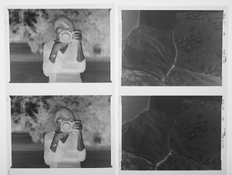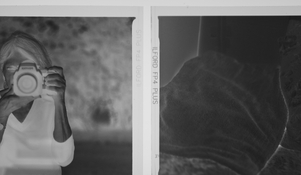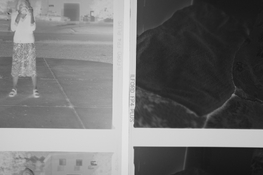For those of you who develop your own film......
Wondering if what a lab told me is true.
I wrote to them because I noticed that the edge info for two 120 FP4 rolls (in same job sent to them) looked very different. On one roll, it was very faint, barely legible. I figured that meant that roll was underdeveloped.
Most of the the photos on that roll looked okay, but I always overexpose, which would compensate to some degree for underdevelopment. There were three photos on that roll where I accidentally did not overexpose (or possibly underexposed) which were thin.
The reply from the lab was: “Edge code density varies – I wouldn’t judge over- or under-processing by it. I checked the log book, and we ran your two rolls of FP4 together on the same rack – so, they were processed the same.”
Attached are photos of negs on my light table from the two rolls. The roll with the darker edge code has images with a lot of light colors which may contribute to the negs looking denser compared to the other roll.
The image in my first jpeg, on what I thought was an underdeveloped roll, doesn’t look bad in terms of density. But, as I said, I tend to overexpose. My third jpeg shows one of the images on that roll which is thin, where I must’ve not overexposed or possibly underexposed.
I haven’t checked all the FP4 film I’ve had developed over the years (at various labs), but I’ve checked about 15 rolls, and the edge info is not as light as the roll discussed here.
The edge info on the Tmax 400 sent with these FP4 rolls looks nice and dark, as has edge info on all the Tmax 400 and HP5 rolls they've developed for me in past six months.
If the rolls were truly developed at the same time, as lab said, it does seem an issue with Ilford. Has anyone seen this themselves? I’ve always looked at edge info for clues re developing.
Thanks for your input.
And, yes, I need to start developing my own film : )
P.S. Unfortunately, I don't have a record of lots the two FP4 film rolls came from. I was keeping a record of that for a while, when I was having another problem with FP4 (the mottling from backing paper).
Wondering if what a lab told me is true.
I wrote to them because I noticed that the edge info for two 120 FP4 rolls (in same job sent to them) looked very different. On one roll, it was very faint, barely legible. I figured that meant that roll was underdeveloped.
Most of the the photos on that roll looked okay, but I always overexpose, which would compensate to some degree for underdevelopment. There were three photos on that roll where I accidentally did not overexpose (or possibly underexposed) which were thin.
The reply from the lab was: “Edge code density varies – I wouldn’t judge over- or under-processing by it. I checked the log book, and we ran your two rolls of FP4 together on the same rack – so, they were processed the same.”
Attached are photos of negs on my light table from the two rolls. The roll with the darker edge code has images with a lot of light colors which may contribute to the negs looking denser compared to the other roll.
The image in my first jpeg, on what I thought was an underdeveloped roll, doesn’t look bad in terms of density. But, as I said, I tend to overexpose. My third jpeg shows one of the images on that roll which is thin, where I must’ve not overexposed or possibly underexposed.
I haven’t checked all the FP4 film I’ve had developed over the years (at various labs), but I’ve checked about 15 rolls, and the edge info is not as light as the roll discussed here.
The edge info on the Tmax 400 sent with these FP4 rolls looks nice and dark, as has edge info on all the Tmax 400 and HP5 rolls they've developed for me in past six months.
If the rolls were truly developed at the same time, as lab said, it does seem an issue with Ilford. Has anyone seen this themselves? I’ve always looked at edge info for clues re developing.
Thanks for your input.
And, yes, I need to start developing my own film : )
P.S. Unfortunately, I don't have a record of lots the two FP4 film rolls came from. I was keeping a record of that for a while, when I was having another problem with FP4 (the mottling from backing paper).
Attachments
Last edited:













 .
.